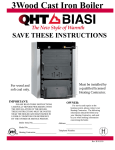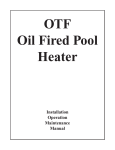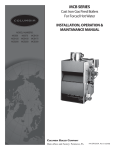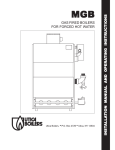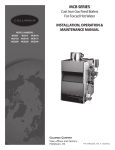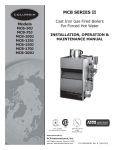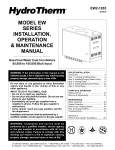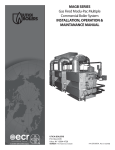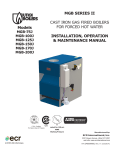Download EFM Heating WCB Operating instructions
Transcript
Installation and Operating Manual for the EFM Wood/Coal Boiler Model WCB EFM Sales Company Emmaus, PA 18049 www.efmheating.com Installation And Operating Instructions For Model WCB Hand Fired Boiler DANGER: This boiler is equipped with a fuse-able plug. It is located inside the boiler. It is not adjustable. In the event that boiler water temperature exceeds approximately 276° F, a dangerous condition, the plug will open and boiler water will fall into the firebox. Follow all operating instructions carefully to avoid a dangerous condition that would result in activation of the fuse-able plug. If the optional domestic hot water coil is installed, a tempering valve, not provided, must be installed to avoid scalding water and the potential for serious burns. Pipe the tempering valve per the manufacturer’s instructions. Application The WCB Hand Fired Boiler is designed for both wood and coal firing. It is provided with a cast iron shaker grate and a firebrick combustion chamber lining with an overhead baffle which provides a double pass for the flue gases for better heat extraction from the fuel being burned. This boiler is primarily intended to be an “Add-On” unit to an existing oil or gas fired forced hot water boiler. This boiler is not intended to be the sole source of heat except for the storage buildings, cabins, etc. where constant steady heat is not required. See instructions under heading “To Set Up Boiler” for proper application. This boiler is not to be used with an automatic stoker. This manual contains information for the installation, operation, care and service of the Model WCB Hand Fired Boiler. Be sure to follow these instructions carefully when making the installation. BEFORE PROCEEDING WITH THE INSTALLATION, BE SURE TO CHECK STATE AND LOCAL ORDINANCE REQUIREMENTS. INSTALLATION MUST BE MADE IN ACCORDANCE WITH THESE ORDINANCES WHICH MAY DIFFER FROM THIS INSTALLATION MANUAL. These instructions are to be saved and given to the equipment owner for operation and maintenance information. This unit is subject to shipping damage during transit or can be shipped with missing parts. Upon receipt, examine unit for possible missing parts or damage. If unit is damaged, notify carrier immediately. If parts are missing, notify factory as soon as possible. The WCB Boiler is shipped in a single package. The boiler is shipped with the baffle, grates, firebrick, fire door and ash pit door in place. The limit aquastat, theraltimeter, relief valve, drain cock, immersion draft control and shaker crank are shipped in the ash pan. Three extra refractory brick (for wood firing) are shipped with the boiler. (See instructions under “Wood Firing”). An optional domestic hot water coil is available on order. Specifications — Model WCB Output Rating - 60,000 BTUH (Wood or Coal) Overall Length - 32-5/8" Cabinet Length - 27-1/4" Cabinet Width - 20-1/4" Cabinet Height - 42-1/2" Supply Tappings - (1) 2" Return Tappings - (1) 1-1/4" Flue Outlet - 7" Dia. Fire Door Opening - 11" x 11" Cast Iron Grates - 3 Firebrick Splits - 10 Maximum Log Length - 20" Shipping Weight (Approx.) - 700 lbs. Do not use or store flammable liquids, especially gasoline in the vicinity of the boiler. Coal Do not burn garbage, gasoline or naptha in this boiler. Install this boiler in accordance with the applicable requirements of N.F.P.A. #211 “Chimneys, Fireplaces, Vents And Solid Fuel Burning Appliances,” 2002 Edition. 1. The WCB Boiler is designed to burn anthracite (hard) coal of the “Chestnut” or “Nut” size. We do not recommend the use of bituminous (soft) coal. Bituminous coal has a high ash and sulphur content and produces byproducts that can corrode the boiler fireside surfaces. 2. An adequate storage bin should be provided for storage. This should be preferably located indoors with easy access for coal truck to deliver the coal with a chute through a cellar window. The storage volume required for one ton of coal A stack thermometer, not provided, must be installed and used to check stack temperature. Stack temperature must be maintained below 600 degrees F. 1 is 40 cubic feet. Be sure the bin is well supported to withstand the side thrust load of the coal. 3. Do not store coal within boiler installation clearances, or within the space required for charging and ash removal. 4. When securing a supplier for your coal and before ordering coal in large quantities, buy a bag or two of the coal you intend to use and try it in your boiler to be sure you are satisfied with its burning quality. Coal varies in type, size, and grade. Just as there is good and bad firewood, there is good and low quality coal. 3. A build-up of creosote over a period of time can lead to a chimney fire. When ignited, creosote makes an extremely hot fire, creating a roaring noise and producing flames and sparks from the top of the chimney. A 316 stainless steel insulated chimney liner will reduce the formation of creosote. 4. One method suggested to reduce creosote build-up is to deliberately have a hot fire for 15 to 30 minutes each day. This hot fire tends to burn off the creosote in very small amounts each day, thus eliminating the build-up problems. Wood Disposal of Ashes 1. Burn dry and well seasoned hardwood, with a moisture content of 20% or less. Seasoned wood will produce less creosote and will provide more usable heat. There are about 8000 BTU’s available as heat from each pound of wood. It takes about 1000 BTU’s to evaporate each pound of moisture from a log. The wetter the wood, the more energy it takes to get the moisture out of the wood and the less energy available to heat your home. Seasoned wood will often show cracks radiating outward, like wheel spokes, from the heartwood toward the bark. Green wood will not show this pattern of cracks. 2. Firewood is best stored outside, under cover, and in a dry location. Store for a period of at least six months to a year prior to using. 3. Softwoods, being resinous, are easy to ignite and burn rapidly with a high flame. However, they burn out quickly, require frequent attention and produce more creosote than hardwoods. Hardwoods, are generally more difficult to ignite, burn less vigorously and with a shorter flame, but last longer, produce more heat and less creosote than softwoods. 4. Do not store wood within boiler installation clearances, or within the space required for charging and ash removal. 1. Ashes should be placed in a metal container with a tight fitting lid. The closed container of ashes should be placed on a noncombustible floor or on ground, well away from all combustible material, pending final disposal. If the ashes are disposed of by burial in soil or otherwise locally dispersed, they should be retained in the closed container until all cinders have thoroughly cooled. Chimney 1. The chimney must be a type suitable for solid fuel and must provide a minimum draft of .04 IN/WG (as measured with a Draft Gage) at the boiler flue exit to provide for the proper operation of the boiler. The chimney should be masonry with tile lining (8" x 8" x 15 ft. high) or metal, insulated, with a 316 stainless steel internal surface (9" dia. inside x 15 ft. high). See Figures 11, 12, and 13 for situations which can cause poor draft conditions in a chimney. 2. The boiler should be connected to its own separate flue. Be sure to check state and local ordinances requirements on chimneys and vent connections before installing. 3. This boiler can present a serious fire hazard if connected to a dirty or inadequate chimney. 4. A non-galvanized flue pipe, not provided, shall be used for connecting the boiler to the chimney. Materials such a black steel, blue steel or stainless steel are acceptable. Creosote 1. When wood burns, the smoke usually contains a substance called creosote which is dark brown or black in color. When the stove pipe or chimney flue temperature drops below 250°F., creosote will condense on the surfaces. At temperatures below 150°F., the creosote deposit is fluid. 2. The amount of creosote in the stove pipe and chimney flue lining varies with the intensity of the fire, the density of the smoke, the dryness of the wood and the flue temperature. A small intense fire is preferable to a large smoldering fire, to reduce the amount of creosote. Ventilation 1. The area in which the boiler is located must have an adequate supply of air for combustion. A total of 400 square inches of free air supply is required. Open basements without storm windows or tight fitting doors will generally permit adequate air infiltration. If the boiler is located in a separate room with a tight door, ventilation 2 Draft Control must be provided to an open area within the building or to the outside. If the building is of tight construction with exhaust fans, an outside air supply that is ducted into the boiler room may be required. 1. The amount of heat produced and level of fire in this boiler is controlled by a non-electrical, metal bellows, immersion type of temperature sensing control. A 3/4" tapping is provided, in the upper right hand corner on the boiler front, to mount this control. Refer to Figure 10 when mounting control. Take care not to damage the control by over-tightening. Make sure on the final tightening that the red mark on the control body and the hexagon screw are on top. 2. The mounting and adjustment of the control arm is to be done when the boiler is up to desired temperature. Refer to section under “Control Settings” for proper adjustment of the draft control. To Set Up Boiler 1. The WCB Boiler must be located on a level, solid, non-combustible surface adequate to support unit weight (approximately 700 pounds). 2. Locate boiler to maintain a minimum of 36 inches clearance on the front, 18 inches to the rear, both sides and top to any obstructions or combustible material. Locate close to chimney to keep flue pipe as short as possible, while maintaining recommended clearances. 3. Refer to Figures 4 or 5 when piping boiler to system. Refer to Figure 3 for proper location of connections to the boiler and control locations. 4. A circulator (not provided) should be installed to provide forced circulation between the two boilers to equalize the water temperature throughout both boilers. See Figure 4. The circulator may be set up to run continuously or it may be controlled by an aquastat control (not provided). 5. Provide valves so the add-on boiler can be isolated from the heating system when not in use. 6. Be sure to mount a pressure relief valve on the add-on boiler, the release pressure on the valve must not exceed 30 PSI. 7. An optional domestic hot water coil can be installed and piped to an existing hot water heater. See Fig. 4. 8. When adding the boiler to an existing system, the water capacity of the system is increased by 17 gallons plus the water in the added piping. Check existing expansion tank size. It may be necessary to add an additional tank or change the existing tank to a larger one to accommodate the add-on boiler. 9. After all piping is complete and controls are mounted (including the draft control - see paragraph under “Draft Control”), fill the boiler and system with water. Purge and bleed all air from system. Pressurize boiler to 30 PSI and check for leaks. 10. It is essential that the boiler be installed with at least one “dump zone” in which hot boiler water is dumped on a temperature over-ride. See Figure 9 for wiring diagram. Flue Pipe Installation 1. A barometric draft control is not supplied with this boiler. A barometric draft control is required by code in some areas. The damper, if used, must be set to maintain a minimum draft of .04 in./water. This amount of draft is required for proper firing. In cases of marginal draft, this damper may impair boiler operation, resulting in smoking or gas-back when fueling the boiler, low heat output, and excessive creosote formation when firing with wood. See Fig. 1 for location of barometric draft control. 2. The flue pipe must be 7" nominal dia. (24 Ga. minimum thickness). The flue pipe should be as short as possible (while maintaining recommended clearances), with a minimum of elbows and must pitch upward to the chimney connection. Maintain 18 inches clearance (minimum) between pipe and combustible material. Secure each flue pipe joint and boiler flue outlet connection with sheet metal screws. Seal opening at chimney connection with boiler putty. See Fig. 1. Install the flue pipe so that it is easily removed for cleaning. 3. Manual flue dampers must not be installed between the boiler and chimney. Electrical Installation 1. All wiring must be in accordance with local codes or in the absence of a local code must comply with the National Electric Code. 2. When doing electrical wiring, refer to Figures 6, 7, 8, or 9. Refer to Figure 6 when using the WCB Boiler as an add on to an existing boiler with constant water circulation between the two boilers. Use Figure 7 for same installation without circulation between the two boilers. Figure 8 is 3 Boiler Operation used when the WCB Boiler is used as an individual heating unit with forced water circulation. Use Figure 9 when the WCB Boiler is installed on a system with zone valves. 3. No electrical connections are required if the WCB Boiler is installed on a gravity hot water system. 4. Use 14 Ga. copper wire for all wiring. Route all wiring to avoid hot surfaces. Be sure all electrical components are well grounded electrically. Wood Firing 1. Three refractory blocks are furnished for wood firing. Lay these blocks evenly spaced, over the grate bars. 2. Before starting a fire: Be sure that the draft damper (on the ash pit door) is fully open. Pull overfire baffle handle outward as far as it will travel. Caution: Flammable liquids must never be used to start or to rekindle a solid fuel fire. 3. To build a fire: Place a small amount o crumpled paper on the refractory blocks. This should be covered with kindling wood and a few small sticks of wood. The paper is then ignited. Once a draft has been created in the flue, larger pieces of wood can be added to the fire. If smoke puffs out into the room, the draft damper should be partially closed until the smoke clears and the chimney vents properly. 4. When a steady fire is established and the flue is up to operating temperature, push overfire baffle handle in toward boiler as far as it will go. Set draft control to maintain desired heat output. 5. This boiler is provided with a cast iron baffle, inside front end of combustion chamber. This baffle ducts preheated air over the fire bed to assure complete combustion of the released unburned gases from the fire bed. A round swivel cover on the boiler above the ash door can be used to admit additional over fire air if desired. Loosen screw, swing cover to desired opening and lock in place by tightening screw. 6. Frequent additions of a small amount of wood will result in more even burning and the maintenance of a continuous hot fire. This will reduce the tendency to produce creosote. 7. When loading the boiler with wood, DO NOT maintain a fire bed above the top of the firebrick lining. 8. It is not unusual to have a little smoke come into the room as you open the door to add more wood. You can generally avoid this by opening the door slightly for a moment before you open it completely. Pulling the overfire baffle handle outward as far as it will go, before the door is opened, is also helpful. 9. Small gas explosions may occur when refueling any wood-burning device, always open the firing door very carefully and keep your face away from the door until it is completely open. 10. It is best to always maintain an ash bed under the fire. When this bed gets too thick, use a poker or stick to poke ashes through the grate (through spaces between the refractory blocks) into the ash pan. 11. Always keep fire door and ash pit door closed when boiler is in operation, maintain all seals in good condition. Control Settings 1. Immersion Draft Control: Since this control is mounted in a horizontal position on the WCB, the red numerals are used when adjusting. This control will maintain the boiler water temperature at the point set on the control. The draft control is calibrated in celsius temperature markings. Refer to table below for Fahrenheit equivalents. F° C° F° C° F° C° 100 38 140 60 180 82 110 43 150 66 190 88 120 49 160 71 200 93 130 54 170 77 210 100 2. Set control at desired water temperature. Start fire in boiler and raise boiler water temperature to point set on control. Observe the water temperature using the supplied temperaturepressure gage. The suggested setting is 180°F. 3. With water temperature in boiler at control set point, slide draft control arm into hole on control (hole with wooden plug). The longer part of the arm (end with knob) must project forward on a horizontal plane or slightly below horizontal. Position arm above hole in draft door on the ash pit door, use the hexagon screw to lock the arm in place. See Fig. 10. Note: Do not remove the wooden plug before inserting the control arm. Press the control arm into the hole, gradually pushing out the wooden plug. 4. Connect chain between draft control arm and draft door. See Fig. 10. Shorten chain to a point that the draft door will be open approximately 1/16" with boiler up to temperature as set on control. 5. The draft control will now raise and lower the fire to maintain the desired water temperature. 6. Set the dial on the L4006B aquastat on the addon boiler at 200°F. 7. Set the high limit at 150°F. and the low limit at 140°F. on the primary boiler. 8. Set thermostat at normal desired temperature. 4 Boiler Operation pieces of ash or clinkers, it may be necessary to break up the ash with a poker, so that it may be shaken more easily through the grates. 10. Always keep fire door and ash pit door closed when boiler is in operation. Maintain all seals in good condition. Coal Firing Warning: All coal fires produce some carbon monoxide, a highly poisonous gas. Improper care or operation can cause carbon monoxide to escape from the boiler, smokepipe or flue. Some conditions which can cause carbon monoxide to escape are: blocked chimney or smoke pipe, poor chimney draft, build up of ashes, or the use of too much fuel. 1. The three refractory blocks, used on the grates for wood firing, are to be removed for coal firing. 2. Before starting a fire: Be sure that the draft damper (on the ash pit door) is fully open. Pull overfire baffle handle outward as far as it will travel. Caution: Flammable liquids must never be used to start or to rekindle a solid fuel fire. 3. To build a fire: Place a small amount of crumpled paper on the grates. This should be covered with kindling wood and a few small sticks of wood. The paper is then ignited. After the fire is started place some coal on the fire. As the coal ignites, keep adding additional coal. 4. When a steady fire is established and the flue is up to operating temperature, push overfire baffle handle in toward boiler as far as it will go. Set draft control to maintain desired heat output. 5. The swivel cover (referenced in Item 5 under Wood Firing) does not have to be used when coal firing. 6. As the burning progresses, a suitable bed of glowing coal is produced. The coals are overlaid with fresh coal at intervals as needed, and the glowing coals ignite the volatile gases in the fresh coal before the gases accumulate. However, if the bed of coals is allowed to become too cool before fresh coal is added, the gases can accumulate before being ignited by the low temperature coal bed. These gases can escape into the dwelling or a mild explosion can occur. Charging the fire with too much coal at one time can also cause this condition. 7. When loading the boiler with coal: DO NOT maintain a fire bed above the top of the firebrick lining. It is advisable to leave a glowing area of already burning coal exposed. 8. Always maintain an ash bed between the fire and the grates. This is done to prevent overheating of the grates which can cause them to warp or burn out. 9. The ashes are dropped into the ash pan by shaking the grates. A grate shaker handle is provided for this purpose. When shaking the grates: Do not try to force the shaker handle. The grates are furnished with a linkage bar that restricts the amount the bars can be moved. It is only necessary to vibrate the grates rapidly to shake down the ash bed. When cleaning large Operation During Power Failure 1. An electrical power failure will not affect the operation of the boiler if it is installed on a gravity feed hot water system, since there is no electrical connections to the boiler under this type of operation. 2. On a circulating hot water system, the flow control valve can be manually opened to use the boiler as a gravity feed unit. In this type of operation, the amount of heat available in the dwelling will be dependent on the size and length of piping. For this reason, some experimenting with the fire level will have to be done to determine the safe fire level to maintain without allowing the boiler water temperature to reach the boiling point. It is advisable to lower the draft control from the normal setting (in the range of 150°F. to 160°F.) until the electrical power is restored. With no power there are no means to pump the water from the boiler on a high limit condition. For this reason it is imperative that the level of fire be maintained very carefully and under constant attention. Periodic Maintenance 1. In order for a solid fuel heating system to operate efficiently and safely, the entire system must be properly maintained. This means that the boiler, chimney connectors and joints, and the chimney flue must be in proper working order and clean. 2. At the end of each heating season, the chimney flue and boiler smokepipe should be thoroughly cleaned of soot and other residues. Then the flue should be inspected for any needed repairs and any accumulations of creosote. If creosote does accumulate, it should be scraped off with a long-handled scraper. Creosote is difficult to remove, so care must be taken to prevent damage to the mortar joints. 3. The inside surfaces of the boiler should also be cleaned thoroughly each year at the end of the heating season. These surfaces can be reached readily through the fire door. Use a wire brush and a scraper to remove all accumulation of soot, creosote and other residues. When cleaning the boiler, remove the sliding overhead 5 Chimney Fire baffle by removing the set screw which secures the baffle handle to the baffle. Remove handle by pulling outward. Drop baffle and remove through fire door. After thoroughly cleaning all inside surfaces of boiler and baffle, check the grate bars and fire brick lining. Replace warped grate bars or damaged fire brick. When reassembling the baffle, be sure the set screw lines up with flat portion on handle rod. This flat provides a seat for the set screw and prevents handle rod from slipping out of the baffle when baffle is pulled forward. 4. If wood is the main fuel used, the above cleaning procedures may have to be done several times during the heating season. In any event the boiler should be inspected on regular basis to check for accumulation of soot or creosote. 5. During the summer months, it is advisable to open the fire door and ash pit door slightly to allow air to circulate through the boiler to prevent condensation and resulting in corrosion on the inside surfaces of the boiler. Cleaning the boiler immediately after the heating season along with air circulation aids greatly in reducing the tendency for corrosion to develop. 1. A chimney fire can be very frightening although in many cases it will sound much worse than it really is due to the loud roar and flying sparks. If you should have a chimney fire, call the Fire Department immediately. Then while waiting for the arrival of fire fighters, the fire can usually be controlled and possibly extinguished by dumping a large quantity of coarse salt on the fire in the boiler. Be sure to close the fire door, ash pit door and draft door to exclude the air from the chimney flue. If possible, avoid introducing water into the chimney itself. The water could damage the relatively brittle heated flue liner. 6 7 8 9 10 11 12 efm Sales Company Emmaus, PA 18049 13 14 PARTS LIST EFM MODEL WCB BOILER CC-7578
















